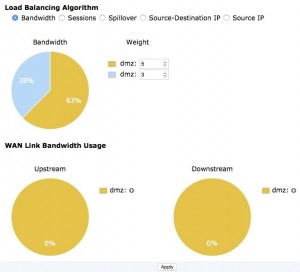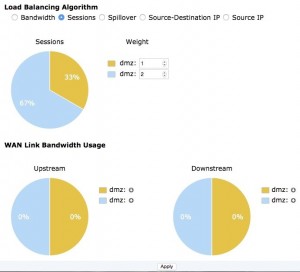WAN link load balancing
In the same way that incoming traffic can be load balanced, outgoing or WAN traffic can also be load balanced and for the same three reasons.
1. Reduce the places in the work flow where a single point of failure can bring the process to a halt.
2. Expand the capacity of the resources to handle the required workload.
3. Have it configured so that the process of balancing the workload is automatic.
Often, it can be just as important for an organizations members to be able to access the Internet as it is for the denizens of the Internet to access the Web facing resources.
There is now a WAN Load Balancing feature located in the Network section of the GUI (“WAN LLB”).
As part of the new WAN Load Balancing feature, the FortiOS 5.2 Router > Static > Settings GUI page has been removed. WAN Load Balancing should be used instead of the 5.2 ECMP Load Balancing Method settings. The 5.2 Link Health Monitor definitions are now only available from the CLI.
WAN links
The basis for the configuration of the virtual WAN link are the interfaces that comprise it. As interfaces are added to the “wan-load-balance” interface, they are added into the calculations that comprise the various algorithms used to do the load balancing.
- While most of the load balancing algorithms are based on equal distribution or weighted distribution, spill over does rely on which interface is first in the sequence, so this should be kept in mind when adding the interfaces.
- The interfaces in the virtual WAN link can be disabled if necessary if work needs to be done on an interface without interfering with the performance of the link.
- There is no requirement that the interfaces be those labeled on the hardware as WAN interfaces.
- In the GUI, to help analysis the effectiveness of the algorithm being used and its configuration, there is a graphic representation of the bandwidth usage of the link.
Load balancing algorithm
Once the interfaces involved has been configured the next step is to determine how the workload will be distributed. 5 load balancing algorithms are available to choose from.
Bandwidth
This is a very straight forward method of distributing the work load based on the amount of packets going through the interfaces. An integer value assigns a weight to each interface. These weights are used to calculate a percentage of the total bandwidth that is directed to the interface.
Example:
- There are 2 interfaces
- Interface #1 is assigned a weight of 5 because it is a 5 MB connection. (There is no requirement to match the weight to the capacity of the connection. It is just a simple way of optimizing the differing capacities in this case.)
- Interface #2 is assigned a weight of 3 because it is a 3 MB connection.
- The total weight is 8 so interface #1 gets 5/8 (63%) and interface #2 gets 3/8 (38%) of the traffic.
Sessions
The session algorithm is similar to the bandwidth algorithm in that it also uses an integer value to assign a weight to each interface. The difference is that the number of sessions connected is what is being measured and not the packets flowing through the interfaces.


